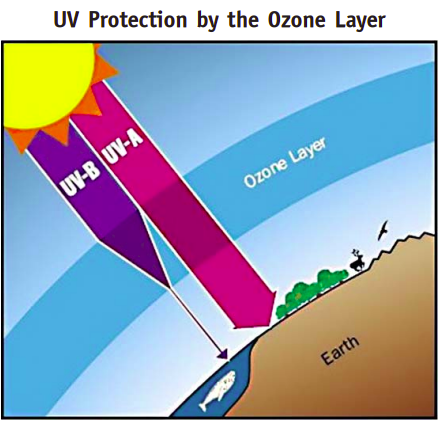Overview about Ozone Layer
Overview about Ozone Layer
What is the Ozone Layer?
The ozone layer is a term used to describe the presence of ozone molecule in the stratosphere. The layer stretches around the entire globe of the Earth like a bubble and acts as a filter for the harmful ultraviolet radiation (UV-B). UV-B radiation is a highly energetic light that originates from the sun and which has severe impacts on human health and the environment.
Good and Bad Ozone
 "Good" ozone is produced naturally in the Stratosphere and is good because it blocks harmful UV radiations from reaching the Earth's surface.
"Good" ozone is produced naturally in the Stratosphere and is good because it blocks harmful UV radiations from reaching the Earth's surface.
Ozone is also present in the lower levels of the atmosphere (i.e. the troposphere), but in very lower concentrations than in the stratosphere. Close to the Earth's surface, most of the Sun's high-energy UV radiation has already been filtered out by the stratospheric ozone layer and therefore the main natural mechanism for ozone formation does not take place in the troposphere. However, elevated concentrations of ozone at ground level are found in some regions, mainly as a result of pollution. Burning of fossil fuels and biomass releases compounds such as nitrogen oxides and volatile organic compounds, usually found in car exhausts, which react with sunlight to form peroxy intermediates, which catalyses to form ozone. This is "bad" ozone. Bad ozone is an air pollutant and is bad because it is harmful to breathe and can damage crops, trees, other vegetation, plastics, rubbers etc.. Ground level ozone is a main component of urban smog.
There is little connection between ground level ozone and the stratospheric ozone layer. Whereas the stratospheric ozone shields the Earth from the Sun's harmful rays, the ground level ozone is a pollutant. Ozone, formed due to pollution at the Earth's surface, cannot replenish the ozone layer. In addition, though ground level ozone absorbs some UV radiation, the effect is negligible.
Why is the ozone layer so important?
The ozone layer is vital to life on the planet's surface. It acts as a filter and prevents the harmful UV-B from reaching the Earth.
If ozone molecules are depleted faster than they can be replaced by new ozone molecule that nature produces, the result is what could be called an ozone deflict. The depletion of the ozone layer will lead to a reduction of its shielding capacity and thus an increased exposure to UV-B radiation.
Last Modified : 9/14/2023
This topic provides an overview about the Nutrient...
This topic provides information about Best practic...
Investment prospects in India's cooling sector thr...
This page contains information about Karnataka sta...
